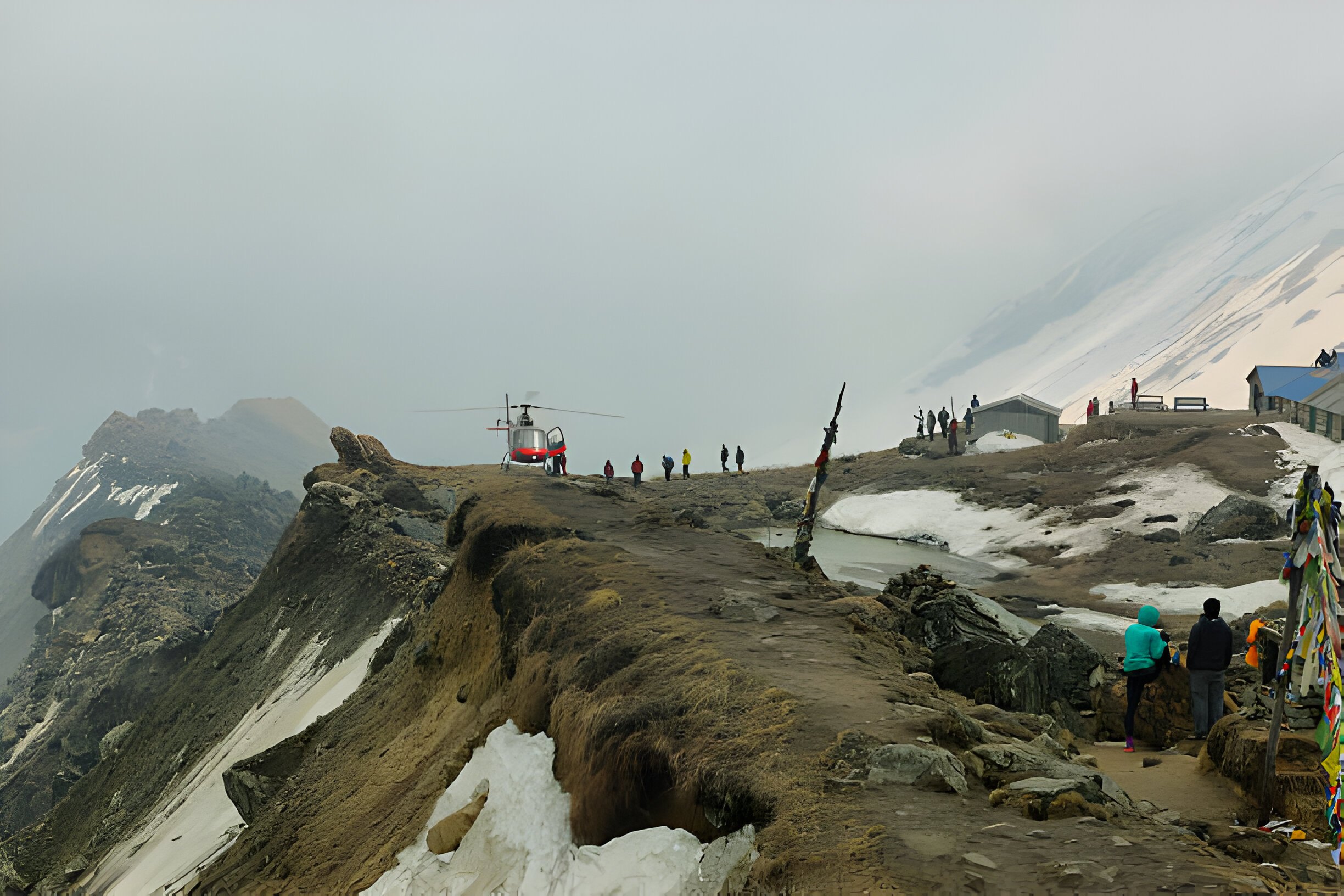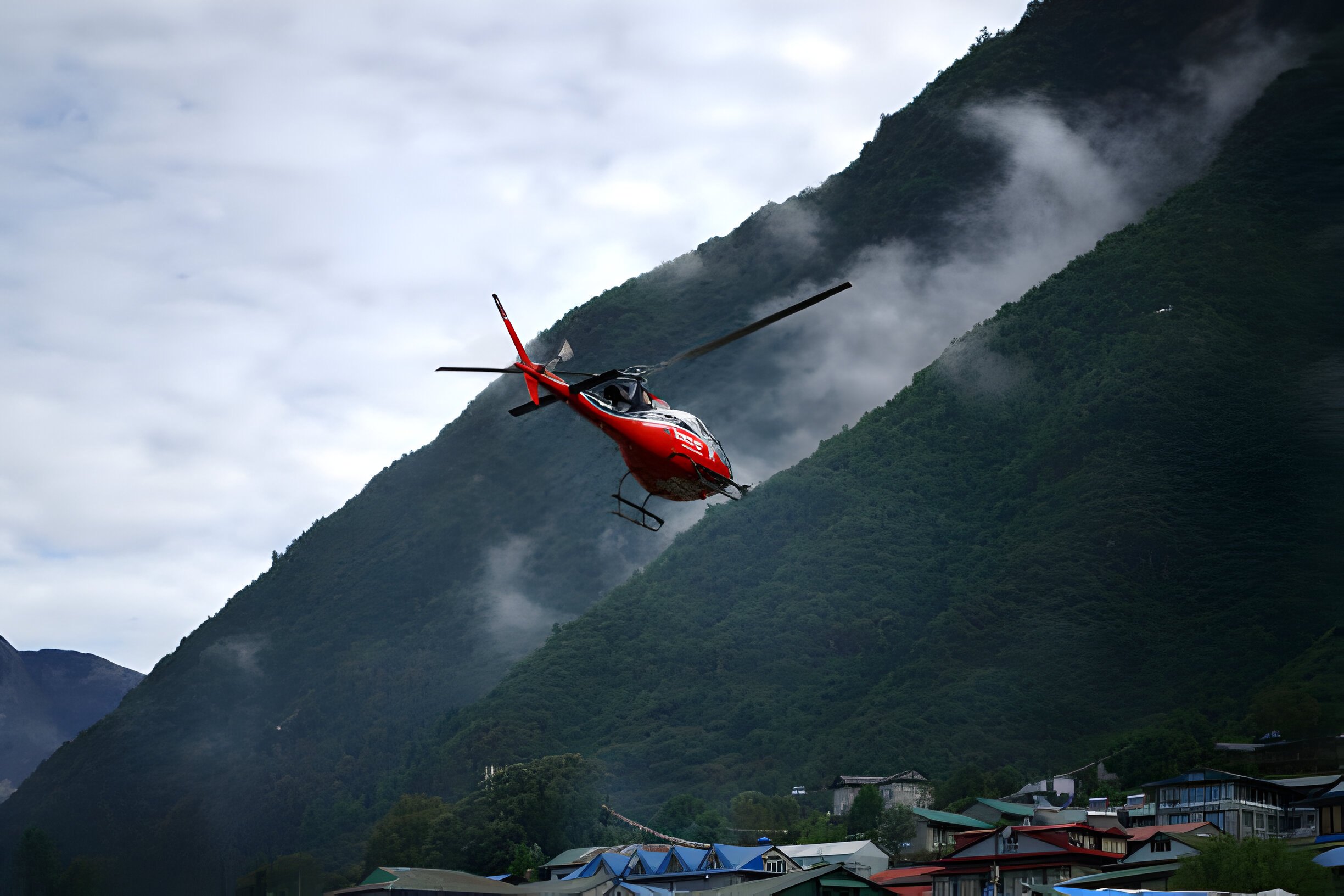- The Need for Helicopter Evacuation in Nepal
- Helicopter Evacuation Process in Nepal
- Benefits of Helicopter Evacuation
- Helicopter Rescue in Everest Region
- Helicopter Rescue in Langtang Region
- Helicopter Rescue in Annapurna Region
- Helicopter Rescue in Manaslu Region
- Emergency Helicopter Rescue in Nepal
- Impact on Lives Saved
- Challenges and Limitations
- Air Ambulance in Nepal
- Rescue Helicopters in Nepal
- Future of Helicopter Evacuation Services in Nepal
- Conclusion
Nepal, a country renowned for its breathtaking landscapes and towering peaks, including Mount Everest, attracts adventurers, trekkers, and tourists from around the globe. While the natural beauty of Nepal is undeniable, the rugged terrain and remote locations present significant challenges, especially in times of emergency. In such scenarios, helicopter evacuation emerges as a vital service, providing life-saving assistance to those in need. This introduction to helicopter evacuation in Nepal will explore why these aerial services are critical for both emergency rescue and medical evacuation operations, particularly in areas that are otherwise inaccessible by traditional means of transportation. Whether it’s a mountaineer suffering from altitude sickness, a remote village hit by a natural disaster, or a tourist in need of urgent medical care, helicopter evacuation services offer a lifeline, ensuring quick and efficient access to necessary aid and medical facilities.
The Need for Helicopter Evacuation in Nepal
Challenges of providing emergency aid in remote mountainous regions
Nepal's diverse and rugged terrain, with its towering peaks and deep valleys, presents significant challenges for delivering emergency aid, especially in remote mountainous regions. Many of these areas are accessible only by foot, and reaching them can take days, which is critically time-consuming during emergencies. Weather conditions in the mountains are notoriously unpredictable and can change rapidly, further complicating rescue efforts. In such situations, conventional means of transportation and communication are often inadequate, making helicopter evacuation critical for saving lives.
Lack of infrastructure and accessibility in Nepal's difficult terrains
Nepal's infrastructure struggles to keep pace with its challenging geography. The country's difficult terrains, characterized by steep slopes and limited road networks, hinders access to many rural and remote areas. In the event of natural disasters like earthquakes and landslides, which are not uncommon in Nepal, these access issues are exacerbated, cutting off entire communities. This lack of infrastructure and accessibility underscores the importance of helicopter evacuations as a swift and effective means of reaching and aiding those in dire need, regardless of their location.
Helicopter Evacuation Process in Nepal
Coordination and communication for emergency rescue operations
The success of helicopter evacuation operations hinges on effective coordination and communication among all involved parties. This includes a range of entities from local authorities and international rescue teams to medical personnel and aviation services. Emergency operations centers often serve as the hub for this coordination, utilizing advanced communication technology to deploy helicopters quickly and efficiently to the rescue site. Precise location information, understanding the nature of the emergency, and clear communication between ground teams and pilots are crucial for the success of these operations.
Role of trained medical professionals during evacuations
During helicopter evacuations, the presence and role of trained medical professionals cannot be overstated. These specialists provide critical, life-saving medical care in-flight, stabilizing patients until they can be transported to a medical facility for further treatment. They are equipped to handle a wide range of medical emergencies, from trauma injuries to acute medical conditions, ensuring the patient's condition does not deteriorate during transit. Their expertise is a vital component of the evacuation process, contributing significantly to the overall effectiveness of these emergency interventions.
Helicopter types and equipment used in rescue missions
Various types of helicopters, equipped with specialized equipment, are used for rescue missions in Nepal. The helicopters selected for these operations must be capable of navigating the country's challenging terrain and rapidly changing weather conditions. Most commonly used are lightweight, high-altitude helicopters designed for agility and stability, such as the AS350 B3e (AStar) and the Bell 407. These helicopters are often outfitted with essential rescue equipment, including winches for air-lifting victims from hard-to-reach locations, stretchers, and advanced medical kits. Additionally, these aircraft are equipped with GPS and other navigation aids to enhance safety and efficiency during operations. This combination of specialized helicopters and equipment enables efficient and effective evacuation missions, essential for saving lives in Nepal's remote landscapes.
Benefits of Helicopter Evacuation
Helicopter evacuation services are crucial for providing urgent medical and rescue operations, especially in areas where conventional vehicles cannot reach. Their unique benefits make them an indispensable asset in emergency situations.
Swift response and reaching isolated areas
One of the most significant advantages of helicopter evacuation is its ability to provide a swift response. Helicopters can be deployed quickly and reach remote or hard-to-access areas with ease. This is particularly vital in emergency situations where time is of the essence and delays can mean the difference between life and death. In Nepal, where rugged terrains and isolated communities are common, helicopters are often the only means of rapid transportation in case of medical emergencies or natural disasters. They can fly over difficult terrains, such as mountains and valleys, without the need for landing space, allowing them to deliver aid and evacuate individuals much faster than ground transport.
Medical capabilities on helicopters for in-transit care
Another key benefit of helicopter evacuation services is their medical capabilities. Many helicopters are equipped with essential life-saving equipment and staffed by medical professionals. This enables the provision of in-transit care, ensuring that patients start receiving necessary treatments immediately, even before reaching a hospital. Features including stretchers, oxygen, emergency medical supplies, and communication systems are commonly found on medical evacuation helicopters. In some cases, helicopters serve as airborne ambulances, equipped with advanced life support systems to stabilize and treat critically ill or injured patients. This capability significantly enhances survival rates and outcomes for patients in critical conditions.
Helicopter Rescue in Everest Region
The Everest Region, renowned for its majestic peaks and rugged beauty, also presents significant challenges for rescue and medical evacuation efforts due to its harsh and unpredictable weather, as well as its remote location. In this context, helicopter evacuation services play a vital role.
Helicopter rescues in the Everest Region are often considered among the most challenging aviation operations worldwide. Pilots must navigate through difficult weather conditions, high altitudes, and terrain that can change rapidly. Despite these challenges, helicopter services have been instrumental in saving lives, whether for climbers suffering from altitude sickness, injuries from falls, or other medical emergencies.
The ability to reach high-altitude base camps quickly makes helicopters essential for rescue operations in the Everest Region. They are not only used for evacuating climbers in distress but also for transporting essential supplies, conducting search and rescue missions, and even for aerial reconnaissance to assess conditions and plan routes.
The importance of helicopter evacuation in the Everest Region cannot be overstated. It is a critical service that supports the local tourism industry by making climbing and trekking ventures safer. For climbers and adventurers, knowing that such services are available provides a sense of security, encouraging them to explore these remote areas while minimizing the risks associated with high-altitude adventures.
Helicopter Rescue in Langtang Region
Langtang Region, known for its breathtaking landscapes and remote trails, is a magnet for trekkers seeking adventure beyond the beaten path. However, its remote location and challenging terrain also mean that, when emergencies arise, conventional rescue methods may not always be sufficient. This is where helicopter evacuations play a crucial role in providing timely assistance to those in need.
Helicopter rescues in the Langtang Region are orchestrated with precision, leveraging the skills of experienced pilots and rescue teams familiar with the area’s unique topography. The process usually involves several steps:
- Initial Contact: The rescue operation begins with an SOS call or signal from the person in distress or from a concerned party.
- Assessment: The rescue team quickly evaluates the situation based on the information provided, including the victim's location, condition, and weather conditions in the area.
- Dispatch: A helicopter equipped with necessary medical supplies and trained personnel is then dispatched to the location.
- Evacuation: Upon arrival, the team provides first aid, if required, and prepares the individual for airlift to the nearest medical facility.
These operations highlight the importance of helicopter evacuations in saving lives, especially in areas where access by land is either impossible or would take too long.
Helicopter Rescue in Annapurna Region
The Annapurna Region, with its famous circuit and base camp treks, draws thousands of hikers from around the globe every year. Despite its popularity and relatively well-marked trails, accidents, acute altitude sickness, and sudden illnesses can still occur, necessitating emergency evacuations.
Unlike the Langtang Region, the Annapurna area is somewhat more accessible due to its popularity and the presence of more established trekking infrastructure. Nevertheless, emergencies requiring helicopter evacuations are not uncommon, with the protocol for such operations being similar:
1. Notification: The rescue begins with an emergency call or notification to the local rescue authorities or a tour operator.
2. Coordination: A coordination center assesses the situation, including the victim’s precise location, which is crucial for a speedy response.
3. Mobilization: A rescue helicopter, often on standby during peak trekking seasons, is dispatched with all necessary equipment and personnel.
4. Evacuation and Medical Aid: The team provides immediate medical aid on the spot, if required, before evacuating the person to the nearest medical facility for further treatment.
Helicopter evacuations in the Annapurna Region are a testament to the evolving safety measures in place to protect the lives of trekkers. These aerial rescues have become an indispensable part of the emergency response strategy in Nepal’s trekking communities, ensuring that help is never too far away, regardless of how remote the location might be.
Helicopter Rescue in Manaslu Region
The Manaslu Region, renowned for its breathtaking beauty and challenging terrain, is a popular destination for trekkers and mountaineers alike. However, its remote location combined with the potential for sudden weather changes increases the risk of accidents and health issues, making the availability of helicopter rescue services critical.
Helicopter rescues in the Manaslu Region are facilitated by a network of aviation services trained for high-altitude operations. These services are essential for several reasons:
- Rapid Response: Helicopter rescues can be mobilized quickly, reaching remote areas within the region in a fraction of the time it would take ground teams. This swift response is crucial in medical emergencies where time is of the essence.
- Medical Evacuation: Conditions such as altitude sickness, frostbite, and acute mountain sickness require immediate medical attention. Helicopter evacuations provide the means to transport individuals to medical facilities quickly.
- Terrain Navigation: The rugged and often unpredictable terrain of the Manaslu Region can make traditional rescues challenging. Helicopters possess the unique advantage of being able to navigate this difficult terrain with relative ease, ensuring that help can reach even the most isolated locations.
These operations require highly skilled pilots and well-maintained aircraft, as well as coordination with local authorities and rescue services, to ensure the safety and well-being of both the evacuees and the rescue team.
Emergency Helicopter Rescue in Nepal
Nepal's diverse terrain, ranging from the low-lying regions to the soaring peaks of the Himalayas, presents unique challenges for emergency rescues. The importance of helicopter evacuation services cannot be overstated, acting as a lifeline for both locals and visitors facing medical emergencies or natural disasters.
Several factors underline the significance of these services:
- Wide Coverage Area: Helicopter services in Nepal cover a broad area, including not just the popular trekking destinations but also remote villages where access to healthcare facilities is limited.
- Diverse Operations: Helicopter evacuations are not limited to trekking accidents but are also crucial during natural disasters such as earthquakes and floods, providing an essential means of transporting injured people and delivering aid.
- Collaboration with Healthcare Providers: Many helicopter services in Nepal work in close collaboration with hospitals and medical centers, ensuring that patients receive immediate care upon arrival. This is particularly important in cases of serious injury or illness, where every second counts.
- Training and Expertise: Pilots operating in Nepal are highly trained in high-altitude flying, with a deep understanding of the local geography and weather patterns. This expertise is vital for ensuring the safety of rescue missions under challenging conditions.
Emergency helicopter services in Nepal are a testament to the country's commitment to ensuring the safety and well-being of both its citizens and the thousands of visitors it welcomes each year. These services not only save lives but also provide peace of mind to those exploring some of the most remote and challenging landscapes on earth.
Impact on Lives Saved
Helicopter evacuation services in Nepal play a critical role in saving lives, particularly in remote and inaccessible areas. These services are essential in scenarios where timely medical intervention can mean the difference between life and death. Many regions in Nepal are only accessible by foot or helicopter, making the latter an invaluable asset for emergency medical services. Helicopter evacuations facilitate the rapid transportation of the critically injured or ill patients to hospitals, significantly increasing their chances of survival. Additionally, these services are not just limited to local inhabitants. Every year, numerous trekkers and mountaineers exploring the Himalayas rely on helicopter evacuations for immediate rescue and medical attention in cases of accidents, altitude sickness, or other medical emergencies. The presence of helicopter evacuation services adds an invaluable layer of safety and security for both residents in remote areas and visitors, thereby directly impacting the number of lives saved in critical situations.
Challenges and Limitations
Despite their critical importance, helicopter evacuation operations in Nepal face several challenges and limitations that can affect their efficiency and availability.
Weather conditions affecting evacuation operations
Weather is a significant factor affecting helicopter evacuation operations in Nepal. The Himalayan region is notorious for its unpredictable weather, which can change rapidly, making flying conditions hazardous. Fog, heavy rain, and sudden snowfall can significantly reduce visibility and make it impossible to navigate safely. Moreover, high winds can make landing and taking off extremely risky. These factors often result in delays or cancellations of planned evacuations, compromising the timely delivery of emergency aid and transportation of patients to medical facilities.
Financial constraints and accessibility issues
Helicopter evacuation in Nepal is expensive, with costs often running into thousands of dollars. This financial aspect can be a considerable barrier for both locals and foreigners, making it a less viable option for many. While insurance can cover these costs for trekkers and climbers, the local population might not have the necessary resources to afford such services. Additionally, the availability of helicopters and trained crew can be limited, especially during the peak tourist seasons when the demand is highest. This scarcity can lead to accessibility issues, prioritizing those who can afford to pay over potentially more urgent cases.
Training and expertise required for effective helicopter rescue
Conducting effective helicopter rescues in the challenging terrain and weather conditions of Nepal requires highly trained and skilled pilots and rescue personnel. Pilots must be adept at navigating through the rugged landscapes and capable of making quick decisions in often-deteriorating weather conditions. Similarly, rescue personnel must be well-prepared to handle a wide range of medical emergencies and ensure the safety and well-being of the patients during the transport. Training and maintaining such specialized teams is both time-consuming and costly, presenting another layer of complexity to providing widespread and efficient helicopter evacuation services.
Air Ambulance in Nepal
The rugged and beautiful terrain of Nepal, while a paradise for trekkers and mountaineers, often poses significant challenges when it comes to providing timely emergency services, especially in remote areas. This is where the air ambulance services come into the picture, playing a crucial role in saving lives. These services are equipped with medical personnel and equipment, ensuring that those in need receive immediate and professional medical care during transit.
Air ambulance services in Nepal are indispensable, particularly for tourists who suffer from acute mountain sickness (AMS), which can prove fatal if not treated promptly. The altitude sickness, combined with Nepal’s difficult terrain, makes ground transportation to the hospital a less viable option in emergencies. Thus, air ambulances are often the fastest and sometimes the only way to get patients to medical facilities capable of providing the required treatment.
These airborne emergency services are not only limited to AMS or injuries related to trekking and mountaineering but are also critical for transporting patients with other medical emergencies from remote villages to hospitals. Considering Nepal’s geographical challenges, air ambulances have become an essential aspect of the country's emergency medical services system.
Rescue Helicopters in Nepal
The concept of a "Rescue Helicopter" is slightly different but complements the air ambulance in Nepal’s comprehensive emergency service framework. While air ambulances are predominantly medical flights, rescue helicopters are more diversified in their operations. They are often deployed in situations such as search and rescue missions, evacuations during natural disasters like earthquakes and landslides, and recovery operations on difficult terrains.
Rescue helicopters in Nepal:
- Are equipped with advanced navigation systems to ensure safety during flights, especially crucial in Nepal’s unpredictable weather and challenging landscapes.
- Have skilled pilots with extensive experience in high-altitude flying, which is essential for operations in the Himalayas.
- Include on-board rescue teams, sometimes accompanied by medical personnel, depending on the nature of the mission.
These helicopters serve a lifeline for mountaineers, trekkers, and local inhabitants alike, providing a vital link to the outside world in times of crisis. They offer hope and a chance for survival by making the inaccessible, accessible. The intervention of rescue helicopters has saved countless lives, underscoring the importance of these aviation services in a country where the topography demands extraordinary measures for emergency and medical rescues.
In conclusion, both air ambulance and rescue helicopter services form an integral part of Nepal's emergency response system. They demonstrate the country's commitment to ensuring the health and safety of not only its citizens but also the many international visitors it hosts every year. These services highlight the adaptability and innovation required to meet the unique challenges presented by Nepal's demanding environment.
Future of Helicopter Evacuation Services in Nepal
Technological advancements in aviation for better rescue operations
The future of helicopter evacuation services in Nepal looks promising with the advent of technological advancements in aviation. Innovations such as enhanced GPS systems for precise location tracking and advanced flight control systems are set to improve the efficiency of rescue operations. Moreover, the incorporation of drones for initial assessment and communication during emergencies will further support helicopter teams by providing vital information before arrival. This will enable faster, safer, and more accurate response efforts, significantly improving the chances of success in emergency rescue missions.
Collaborations and partnerships to enhance emergency response in remote areas
Strengthening helicopter evacuation services in Nepal also involves collaborations and partnerships between government bodies, local communities, and international aid organizations. These alliances aim to establish a more robust emergency response framework, especially in remote and inaccessible regions. By pooling resources, sharing expertise, and coordinating efforts, these partnerships ensure that adequate training, equipment, and financial support are available. Such collaborative efforts not only enhance the capacity to respond swiftly to emergencies but also play a crucial role in building resilient communities prepared to face natural disasters and medical emergencies.
Conclusion
Concluding, helicopter evacuation services in Nepal have become indispensable in providing critical support in emergencies, particularly in regions where traditional rescue methods are not feasible. The rugged terrain and isolated locations of many of Nepal's villages and trekking routes make these aviation services essential for rapid medical evacuations and disaster response. Whether it's ferrying injured trekkers, providing aid to remote communities, or responding to natural disasters, helicopter evacuations ensure that help is never too far away. The integration of these services with Nepal's healthcare system and disaster management efforts highlights a commitment to saving lives and facilitating access to urgent medical care. As we move forward, the continued improvement and expansion of helicopter services in Nepal will undoubtedly play a pivotal role in enhancing the safety and well-being of both locals and visitors alike.










